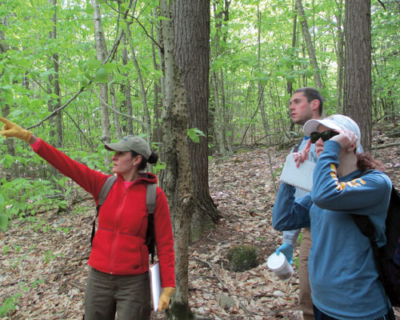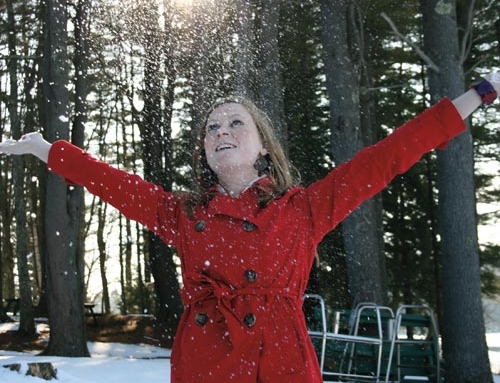 Outside the classrooms of Harold Alfond Hall and the labs in Mercy Hall, 350 acres of the College sit in a perfect stillness – at least that’s how they appear. On a May morning gleaming with spring mist, Joe Murphy ’13, Erin Wright-Little ’16 and biology instructor Camilla Fecteau hike under the towering branches of American beech, eastern hemlock and eastern white pine trees that line the College’s cross country trails. There’s the sound of their footfalls and clothes ruffling with each step. Then, they stop. Fecteau points up to a tree some 50 feet ahead. A quick succession of rapping echoes down through the leaves.
Outside the classrooms of Harold Alfond Hall and the labs in Mercy Hall, 350 acres of the College sit in a perfect stillness – at least that’s how they appear. On a May morning gleaming with spring mist, Joe Murphy ’13, Erin Wright-Little ’16 and biology instructor Camilla Fecteau hike under the towering branches of American beech, eastern hemlock and eastern white pine trees that line the College’s cross country trails. There’s the sound of their footfalls and clothes ruffling with each step. Then, they stop. Fecteau points up to a tree some 50 feet ahead. A quick succession of rapping echoes down through the leaves.
When Fecteau identifies the branch where the sound is coming from, she tells Wright-Little that it’s a hairy woodpecker and to write it down on their data sheet.
“‘Harry,’ like Harry Potter?” she asks.
“No. ‘Hairy,’ like hairy,” Fecteau says. They laugh at this case of mistaken identity, but that’s a part of why the group is out this morning. This team of three is trekking through the trails for Fecteau’s May semester course, The Flora and Fauna of Saint Joseph’s College Campus. Their goal: to identify and document the wildlife in the woods that encompass the College. An explorative, hands-on, three-week course, the results will be used for future study and comparisons. “It’ll be interesting to start a catalog of data – a presence and absence count – to see what’s there,” says Fecteau. Using amphibian pitfalls, mammal traps, game cameras and their eyes, they name and count whatever they find on and off the trails.
There’s another side to this course, as well. “I want students to connect with the campus and the environment,” says Fecteau. “We have a unique environment here on Sebago Lake. I want to survey the plants, mammals, amphibians, reptiles and birds. It’s as much as an adventure for me as it is for the students.”
They begin each morning with a meeting in a Mercy Hall lab, where they load their backpacks with mammal bait (balls of peanut butter coated in bird seed), cotton balls, rubber and leather gloves, field guides, cameras, tape measures, empty data sheets, and water. On the whiteboard Wright-Little and Murphy have three plant and animal species written under their names. Each day, “They’re given species we’ve seen on campus,” says Fecteau. “Their assignment is to do research and create a species write-up that contains pertinent life history information about each. Combined, they become our own version of a field guide to SJC.”
Their hike begins at a trailhead behind Saint Joseph’s Hall, which proves to be a productive area. Around Stone Pond, the group sees a green heron and a great blue heron. Floating on the water’s smooth surface is a painted turtle.
Across from Stone Pond is a clearing filled with fallen trees, saplings, lowbush blueberries and pink lady’s slipper. This area is perfect for a plant transect – a cordoned-off area of 10 x 10 meters in which to perform a species count. “We use meter tapes and posts to mark the transects,” says Fecteau. “I start at one corner and use a compass to measure north and east. Wherever the starting point is, we always go north and east from there. I use a GPS to mark where our sites are located.” In all, Fecteau and her class did six transects.
Back on the trail, they listen to birdcalls and record what they see on their data sheets. This, it turns out, is Wright-Little’s favorite part of the excursion. “I had already fallen in love with bird mornings at my high school,” she says, “but finding even more and having that feeling of ‘I know what bird is calling’ feels great. I feel much more confident with my knowledge of the campus [habitat].”
At one point, the group listens, and Wright-Little mimics what she hears. “Teacher-teacher,” she says. “That’s an ovenbird.” She loves hearing the common yellow throat, too. “They are so bright and have a really cool song: ‘witchity-witchity.’”
That’s the excitement and engagement Fecteau wants as a result from students taking this course. It’s about field knowledge, but she also likens it to understanding things in the bigger picture. “I taught undergrad biology labs at USM. It was hard. I was unable to do almost anything on campus. I lived on a tree farm at the time, and I brought plants in from there. I collected water samples from someplace else and trucked them in. It creates a disconnect for students. They don’t know where these things came from.”
So, when Murphy removes a deer mouse from a Sherman trap behind Saint Joseph’s Hall, how does that connect him with other parts of life? “It’s like solving a mystery,” Fecteau says. “We’re at the edge of a glacier that used to be here 12,000 years ago. It dumped a lot of sand. So what species like to grow in sand? We’ve got white pine and red oaks. Those plants bring in certain animals.” Everything, she says, has an impact on everything else.
“I like to create opportunities for students to make those connections between all their classes.”
by David Svenson
Tools of the Trade
Amphibian Pitfall
This trap looks like three low fences which all cross at one central point. Called a pitfall array, the meeting point contains three holes in the ground. Amphibians walk along the fence until they meet in the middle and safely land in the holes. Collected, counted and identified, they are released in the morning.
Game Cameras
These motion-sensor digital cameras take photos in the day and night, stealthily recording any activity. Images are viewed on a computer back in the lab. Fecteau uses four of these cameras.
Plant Transects
An area of 10 x 10 meters, the plants found in this area are identified and counted, giving a picture of flora variety and density.
Sherman Traps
These hollow, rectangular metal containers are filled with bait. This entices small animals like deer mice. Once inside, a door closes, keeping them there until they are collected and released in the morning. A cotton ball is included in the trap, which can be used as a bed for warmth if the night is too cold.
Field Guides
These books contain plants, birds, mammals and amphibians of all kinds. These are a researcher’s ultimate guide for identifying animal and plant life.
